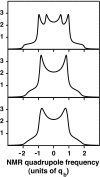Theory of the deuterium NMR of sterol-phospholipid membranes
- PMID: 16432189
- PMCID: PMC1360583
- DOI: 10.1073/pnas.0510514103
Theory of the deuterium NMR of sterol-phospholipid membranes
Abstract
A general theoretical model is described for the NMR spectra of mixtures of sterols and deuterium-labeled phospholipids. In the case of homogeneous membranes, the average quadrupole splittings are determined by equilibria between lipids in cholesterol-phospholipid complexes and lipids not in complexes. Chemical exchange of lipids between those in the free state and those in the complex state affects the deuterium resonance line shapes. The lifetime of a phospholipid molecule in an ergosterol-dipalmitoylphosphatidylcholine complex is estimated to be of the order of 10(-5) s on the basis of the observed line broadenings. In the vicinity of a critical point of a cholesterol-phospholipid mixture, fluctuations in the concentration of complexes also can contribute to the deuterium nuclear resonance line broadening. At the critical point, the temperature derivative of the concentration of complexes is discontinuous. There is a corresponding jump in the calculated heat capacity as well as in the temperature derivative of the deuterium NMR first moment.
Figures






References
-
- Finean, J. B. (1953) Experientia 9, 17–19. - PubMed
-
- Dervichian, D. G. (1958) in Surface Phenomena in Chemistry and Biology, eds. Danielli, J. F., Pankhurst, K. G. A. & Riddiford, A. C. (Pergamon, Oxford), pp. 70–87.
-
- Engelman, D. M. & Rothman, J. E. (1972) J. Biol. Chem. 247, 3694–3697. - PubMed
-
- Hinz, H. & Sturtevant, J. M. (1972) J. Biol. Chem. 247, 3697–3700. - PubMed
-
- Darke, A., Finer, E. G., Flook, A. G. & Phillips, M. C. (1972) J. Mol. Biol. 63, 265–279. - PubMed
Publication types
MeSH terms
Substances
LinkOut - more resources
Full Text Sources

